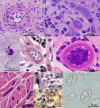Human infections with Sarcocystis species
- PMID: 25715644
- PMCID: PMC4402950
- DOI: 10.1128/CMR.00113-14
Human infections with Sarcocystis species
Abstract
Recurrent outbreaks of muscular sarcocystosis among tourists visiting islands in Malaysia have focused international attention on sarcocystosis, a disease once considered rare in humans. Sarcocystis species require two hosts, definitive and intermediate, to complete their life cycle. Humans can serve as definitive hosts, with intestinal sarcocystosis for two species acquired from eating undercooked meat: Sarcocystis hominis, from beef, and Sarcocystis suihominis, from pork. Symptoms such as nausea, stomachache, and diarrhea vary widely depending on the number of cysts ingested but appear more severe with pork than with beef. Humans serve as intermediate hosts for Sarcocystis nesbitti, a species with a reptilian definitive host, and possibly other unidentified species, acquired by ingesting sporocysts from feces-contaminated food or water and the environment; infections have an early phase of development in vascular endothelium, with illness that is difficult to diagnose; clinical signs include fever, headache, and myalgia. Subsequent development of intramuscular cysts is characterized by myositis. Presumptive diagnosis based on travel history to tropical regions, elevated serum enzyme levels, and eosinophilia is confirmed by finding sarcocysts in muscle biopsy specimens. There is no vaccine or confirmed effective antiparasitic drug for muscular sarcocystosis, but anti-inflammatory drugs may reduce symptoms. Prevention strategies are also discussed.
Copyright © 2015, American Society for Microbiology. All Rights Reserved.
Figures






References
-
- Dubey JP, Speer CA, Fayer R. 1989. Sarcocystosis of animals and man. CRC Press, Boca Raton, FL.
-
- Senaud J. 1967. Contributuion a l'etude des sarcosporidies et des toxoplasmes Toxoplasma. Protistologica 3:169–232.
-
- Heydorn AO, Rommel M. 1972. Beitrage zum Lebenszyklus der Sarkosporidien. II. Hund und Katze als Ubertrager ser Sarkosporidien des Rindes. Berl Munch Tierarztl Wochenschr 85:121–123. - PubMed
Publication types
MeSH terms
Substances
LinkOut - more resources
Full Text Sources

